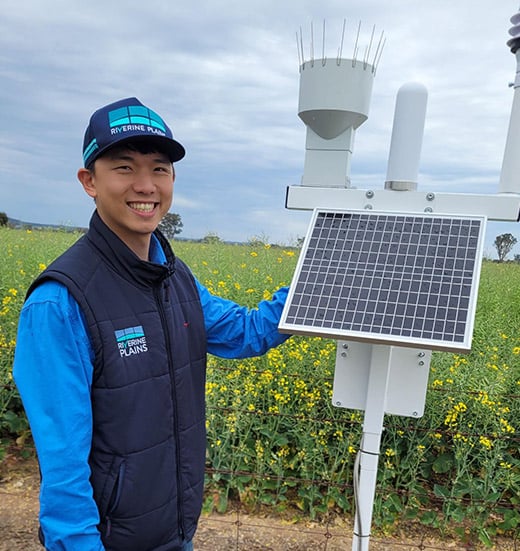Local weather & soil moisture
Providing local farmers across the Riverine Plains with real-time weather and soil information.
Real-time data, local decisions
Riverine Plains manages an extensive network of on-farm weather stations and soil moisture probes across north-east Victoria and southern NSW. This network fills the gap for farmers and communities located too far from official Bureau of Meteorology sites, delivering accurate, localised information that farmers can rely on.
Access the Riverine Plains Weather & Soil Moisture Network
User name: rivplains@pairtree.co
Password: RivPlains!RWSN2024
FREQUENTLY ASKED QUESTIONS
Learn how weather and soil data can guide your on-farm decisions.
Need more help?
Getting started with the Riverine Plains Weather & Soil Moisture Network is easy. Our user guide walks you through everything from logging in to understanding the data, with simple tips to make the most of your local weather and soil information.
What are on-farm weather stations?
On-farm weather stations provide local rainfall, wind speed, wind direction, temperature and relative humidity information, recorded in real-time.
This can be especially useful when farmers are deciding whether or not conditions are suitable for spraying or harvesting.
Having access to temperature data records can also help farmers identify if a significant frost or heat event has occurred, especially if it has the potential to impact crops at sensitive stages of development. This can allow farmers to make more informed decisions about crop management.
What are soil moisture probes?
Soil moisture probes provide an understanding of how much water is available in the soil to support crop growth and development. They are installed at various depths across the soil profile and can indicate the depth from which plant roots can extract moisture throughout the growing season.
Having soil moisture information available at the start of the season can help farmers make decisions about their crop choice based on likely seasonal outcomes. For example, farmers may not sow high-risk crops like canola if there is a lack of moisture across the root zone and dry conditions are forecast early in the season.
Understanding the capacity of different soil types in the region to store water, and how quickly water is being extracted by crops, allows farmers to make more strategic management decisions regarding crop inputs. In dry seasons, this information can also help farmers decide whether to cut a crop for hay or take the crop through to harvest if enough soil moisture is available.
What should I consider when looking at soil moisture probe data?
The Riverine Plains soil moisture probe network covers a variety of soil types and locations.
When choosing an individual probe to use as a reference, it’s important to consider how similar the soil and crop type are to yours, as well as how close it is to your location.
How is soil moisture data is collected?
The soil moisture probe (capacitance sensor) is a long tube, the top of which is placed 30cm below the soil surface. This means the probe does not measure transient surface moisture and instead is more focused on moisture at depth, where the roots are extracting water.
Moisture measurements are taken in 10cm increments down to 140cm depth, with the sensors measuring soil moisture in an 8-10cm radius from the probe.
How does soil type affect probe data?
Soil type will affect how data from the probes is interpreted.
Consider that a soil or layer containing a higher sand content will have a greater moisture content, with most of the soil water able to be extracted by plants. While this moisture is readily available, it is also rapidly depleted and recharged.
A soil or layer containing a higher clay content can hold more water, however only a small proportion of this water can be accessed by plant roots, due to it being strongly held by the clay particles.
Soils with increased clay contents have higher total values, but a narrower plant available water (PAW) range. As the moisture in clay soils is strongly held by the clay particles, it is only slowly depleted, which is of high value under drying conditions, due to its slow release characteristics. This enables the soil to continue supplying water to roots for a longer period.
Funding partners
Our network of on-farm weather stations and soil moisture probes received funding from the Australian Government through the Preparing Australian Communities Program, and the Victoria Drought Resilience Adoption and Innovation Hub, with contributions by host farmers.

JOIN RIVERINE PLAINS
Riverine Plains provides opportunities to see new research and innovation, connect with rural communities, and attend informative and practical events.

